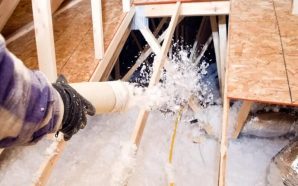If you are having problems with moisture in your basement, you may want to learn how to waterproof your basement. It can be a do-it-yourself project, or it can be a complicated job that requires a foundation contractor. Before you begin waterproofing your basement, you should first find the source of the moisture. Since concrete is porous, you can usually see wet streaks along the edges of cracks or the corners of windows, and between the mortar joints of walls. Water may also be entering your basement through cracks and around pipes in the basement.
Dehumidifiers and Insulation:
There are several methods for basement waterproofing, including adding a perimeter drain or landscaping around your property. Water will flow away from your foundation when you put in a perimeter drain, so it is a good idea to install a full drainage system if possible. However, some people experience problems with moisture in their basement due to excessive humidity or condensation. In these cases, dehumidifiers and insulation help keep the basement dry.
Infestations:
Insects living in your basement are a sign of a larger problem. These insects thrive in dark, damp areas. A moist basement can be a breeding ground for termites and cockroaches. This can pose a health risk if they are not controlled. To protect your home structure and prevent future infestations of a variety of insects, you should waterproof your basement. It is worth the money to protect your home’s structure.
Applying A Waterproof Paint:
Another option for waterproofing your basement is applying waterproof paint. This type of paint has an acrylic formula and is much thicker than ordinary wall paint. One gallon of waterproof paint will cover approximately 75 square feet of masonry walls. One gallon of standard paint covers about 300 square feet.
Although this method may be a bit complicated for a DIY project, it is still effective and can be reapplied if necessary. Waterproof paint is also a viable option for wall waterproofing when used in conjunction with interior basement drainage systems. While plastic panels do not stop water from getting through the walls, they can help prevent water from destroying your basement.
Interior and Exterior Waterproofing:
While interior waterproofing methods are the least expensive and easiest, exterior waterproofing may be the most expensive and requires a significant amount of labor. The process of waterproofing your basement requires extensive preparation and construction and has several drawbacks if you are adding to an existing home. However, you can still waterproof your basement by utilizing exterior waterproofing. If you are planning on building a new home, it may be the most cost-effective option.
While interior waterproofing is a good option for preventing excessive humidity, this doesn’t solve the underlying problem of moisture. The bigger problem is usually outside, and you’ll need to install downspouts and gutter extensions to channel the water away from your home. Then, you can add waterproof paint or sealant to the walls, if necessary. Lastly, you’ll need a sump pump. Ultimately, the best solution will depend on your own needs.
When you have decided that waterproofing your basement is right for you, consider a few signs to keep in mind. If you’ve noticed a wet carpet, a damp basement is a sign that you need to waterproof your basement. Additionally, you should also check for visible mold. While mold may be hard to see, it can cause respiratory issues and fungal infections, which can lead to serious illness. You may want to consider investing in a dehumidifier as well.
Prevent Mold Growth:
Besides preventing flooding, waterproofing your basement can prevent mold growth in your basement. Not only does this prevent mold, but it also prevents a lot of expensive repairs. And you can’t beat the peace of mind that comes from knowing that you’ve waterproofed your basement. If you have ever flooded, you know that mold growth isn’t fun.
A good basement waterproofing plan should incorporate a sump pump. Ideally, the sump pump will pump out water from the sump pit and prevent flooding in the basement. The right sump pump should be sized to handle the volume of water that could come from a broken pipe. If you’re concerned about flooding, you’ll want to consider flood insurance coverage. But what if your basement floods? Fortunately, there are several ways to prevent flooding in your basement.









